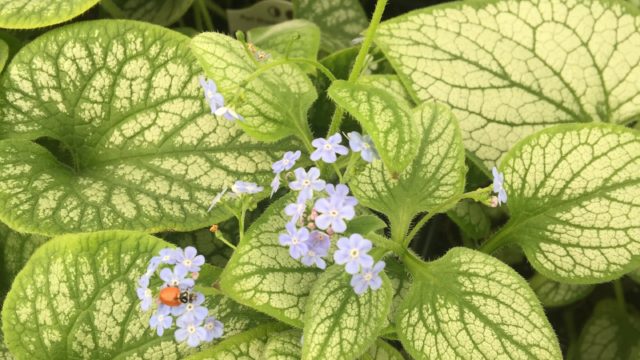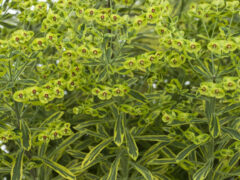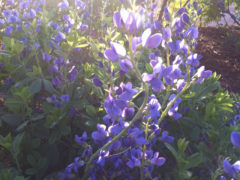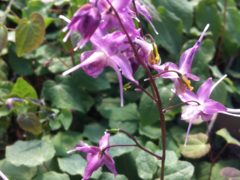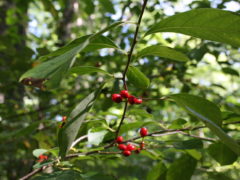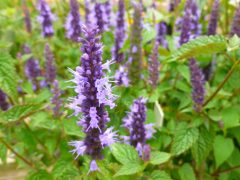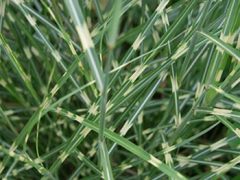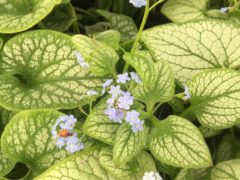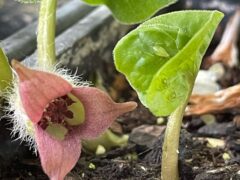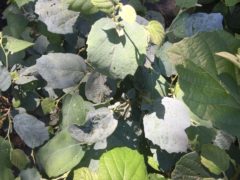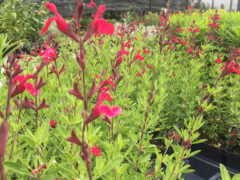As neighborhoods grow into once wild areas and predator populations dwindle, deer are becoming common garden visitors even in the bustling suburbs. The only way to guarantee the safety of landscape plants is to physically protect them inside fences or cages. In cases where that’s not an option, try using plants deer find distasteful to avoid losing plants in your gardens. Deer might take a nibble here and there, but they’re more likely to move along to more palatable options.
Here’s a list of some beauties they especially dislike. For a full list click here.
‘Ascot Rainbow’ spurge
Euphorbia x martinii 'Ascot Rainbow'
The striking variegated foliage of 'Ascot Rainbow' is looks fantastic from spring through fall. Selected for its highly ornamental variegated flower bracts and narrow, grey-green leaves with a striking yellow edge. Plants are topped by clusters of variegated cream, lime, and green "flowers" in spring. In the cooler months, the foliage at the ends of the stems becomes flushed with shades of red, pink, and orange. Overwinters reliably with excellent drainage. Gorgeous in the garden bed and showy enough for container plantings. Heat and drought tolerant.
false indigo
Baptisia australis
Related PlantsPerennial Plant Association 2010 Perennial Plant of the Year!
Baptisia australis is an upright native perennial which occurs in rich woods, thickets and along stream banks from Pennsylvania south to North Carolina and Tennessee.
Easily grown in average, dry to medium, well-drained soil in full sun to part shade, false indigo grows best in full sun. Tolerates drought and poor soils. Plants form slowly expanding clumps with deep root systems that should not be disturbed once established. Shearing foliage after bloom helps maintain rounded plant appearance. Beautiful, showy native plant!
Plants feature lupine-like flowers in erect 12" racemes over clover-like blue-green foliage. Spring flowers give way to inflated seed pods up to 2.5" long which turn charcoal black when ripe and have considerable ornamental interest. Seed pods were once popularly used by children as rattles. Now we have iPods.
Stems with seed pods are valued additions to dried flower arrangements.
According to the North American Butterfly Association –
Blue Wild Indigo belongs to the plant family Fabaceae, also known as the pea family. Plants in this plant family feed a number of caterpillars. Depending on your location and availability of competing food plants (most notably crown vetch and alfalfa), the following caterpillars may use blue wild indigo for food:
[plant id="5140"]
[plant id="6099"]
Frosted Elfin: Caterpillars eat flowers and young seedpods. Frosted Elfin is not a common garden butterfly.
Orange Sulphur: Caterpillars eat the leaves of many plants in the pea family. Feeding occurs at night.
Clouded Sulphur: Caterpillars eat leaves of many plants in the pea family.
Hoary Edge Skipper: Individual eggs are laid in flower buds. Caterpillars eat flowers and seedpods. Hoary Edge is found only in localized populations and is not a common garden butterfly.
Wild Indigo Duskywing: A widespread butterfly that is fairly common in its range.
Eastern Tailed-Blue: A common garden butterfly. Caterpillar eggs are laid on flower buds and the caterpillars then eat the bud, flowers, and seeds.
‘Lilafee’ barrenwort, bishop’s hat
Epimedium grandiflora ‘Lilafee’
Dense, clump-forming, deciduous perennial that grows 10-15” tall with a spread to 18-20". Native to woodland areas of Japan, Korea and Manchuria, the pale rose to violet sepals and white petals bloom in above the foliage in spring. These delicate looking woodland perennials are actually pretty tough! 'Lilafee' produces racemes of long-spurred, lavender-violet flowers in spring well above the foliage. Compound, medium green leaves with spiny-toothed, oval leaflets (to 3" long) on wiry stems form attractive foliage mounds. New leaves in spring emerge beige with a red tinge, mature to green and turn red in fall. 'Lilafee' is sometimes called 'Lilac Fairy'.
spicebush
Lindera benzoin
Large, multi-stemmed shrubs have aromatic twigs and foliage. Spicebush is an important native plant for birds and a larval host plant for the spicebush swallowtail. Male and female flowers occur on separate plants, and the females have bright red fruits in fall.
‘Little Adder’ Korean mint, anise
Agastache rugosa 'Little Adder'
An excellent pollinator plant, ornamental, herbal, and culinary herb. Both flowers and leaves have a delicate licorice scent reminiscent of rootbeer. Blossoms make attractive garnishes and are often used in Chinese-style dishes. Excellent in salads. While 'Little Adder' is half the height of 'Black Adder' and 'Blue Fortune', it's twice as floriferous which means more nectar for the pollinators. TRY THE NATIVE! Related Plants [plant id="5800"]
‘Zebrinus’ zebra grass
Miscanthus sinensis 'Zebrinus'
Horizontal yellow bands on wide foliage that grows 4-6' tall and 3-5' wide. Tolerates poorly drained soils. [gallery columns="1" size="medium" link="file" ids="6088"]
Brunnera ‘Jack Frost’ bugloss
Brunnera macrophylla 'Jack Frost'
Perennial Plant Association 2012 Perennial Plant of the Year!
Foliage is intricately washed with a striking silver, crackle-like finish. Dark green leaves are heavily frosted which allows only the green veining to show through.
From mid to late spring, baby blue, blossoms that resemble forget-me-not are held in clusters over the shimmering foliage that brightens shady areas in borders or woodland settings or as a groundcover. A beautiful and low-maintenance addition to the shade garden.
wild ginger
Asarum canadense
This low, colony-forming perennial grows large, velvety, heart-shaped leaves with a darkish red-brown to green-brown flower. The solitary flower is at ground level, hidden below the leaves. The fleshy rootstock has a strong, gingery flavor.
‘Blue Shadow’ Fothergilla
Fothergilla × intermedia 'Blue Shadow'
White honey-scented flowers at branch tips on a mounded shrub featuring two-tone blue-green foliage in spring followed in fall with stunning fall colors of red, orange and yellow. Provides unique color to the landscape as a foundation plant and mixed borders. Best bloom and color when planted with some sun. Deciduous. A branch sport of Fothergilla 'Mount Airy', 'Blue Shadow' is similar except for its leaves which emerge green in spring and mature to striking powder blue.
Furman’s Red Texas sage
Salvia greggii
Blooms in late spring and again in fall with bright red flowers that attract the hummingbirds. Aromatic foliage. A 2005 Plant Select winner.
